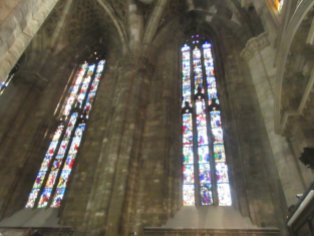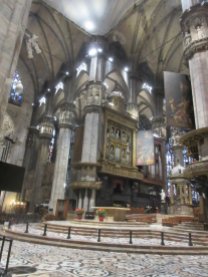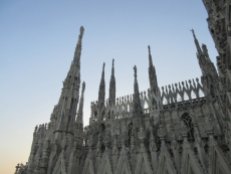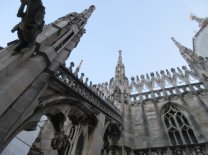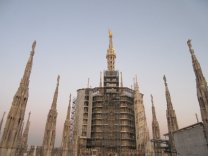After seeing the outside of the Duomo on the night we arrived, we knew that we had to go back to explore further. We went to the ticket office and purchased two tickets for $16 euros each, which allow access to the Cathedral and archeological site below, the lift to the terraces, and the museum. We went in the early afternoon with the goal of being on the terraces at sunset. The last group up to the roof goes at 6:00 pm, it is closed at 7:00 pm and you can stay one hour. We decided to start inside the Cathedral and we entered around 3:00 pm.
I guess I should start with the fact the construction of the Duomo took 600 years and is constructed entirely of marble. As soon as we entered inside, we were awestruck by the enormity. It was almost the feeling of being paralyzed because you can’t move. I stood there with my mouth open. We have been in some beautiful cathedrals and historical places like Saint Peter’s Basilica in Rome and the Church of the Holy Sepulchre in Jerusalem to name a few, but the Duomo, in my opinion, tops them all. It was a visual overload!
When I can finally move and start to take in the things I am seeing, I am overwhelmed again by the intricate details in everything. The beautiful patterns and colors of the floor, the deep rich wood benches, the giant columns with such detail and the Gothic styling. The ceilings with their height and arches, and the colorful windows telling story after story. It hits me that artisans were constructing this in the 1,300s! No power tools, no heavy equipment. My eyes start to fill up and I whisper to Kirk, “It’s so beautiful, it makes me cry.” Just to think of the labor and love that went in to every element just blows the mind!
Down each side, there are alters paying tribute to a Saint or dignitary interned there, each with their own individual sculptures and artwork. In the center you notice the pipes for the organ and then more and more and I find out there are 16,000! The enormous canvas paintings hanging like tapestries from above telling the story of helping those who are sick or in need and you can feel the compassion pour out.
The Cathedral is built in the shape of a cross with the main alter in the middle and two major alters on each side. At the far end, which would be the top of the cross, and above the three largest stained glass windows, there is a red light shining down on the wall which points to the Holy Nail, one of the nails from the cross of Christ, which is the most precious of relics here. It is ceremoniously brought down once a year during the Right of Nivola in a device, reputedly made by Leonardo da Vinci, that lifts the priest up as if he is floating. It used to be placed into a golden cross and paraded through Milan, but today it does not leave the Duomo.
There is an infant struggling for his life back in Santa Maria. I stop at the alter of Christ, light a candle and say a prayer for him and his family. Believing in a God of miracles and having faith in His plan, I pray for miraculous healing that the doctors can’t explain. I know that God hears my prayers wherever I am, but I was “moved” and thus obedient. In fact, anyone reading this post, join in prayer for Ezra and his family.
As we continue to explore, there is an unusual statue of a man. It is not smooth like the others. We find out that it is St. Bartholomew, who was skinned alive and his skin is draped across his shoulders. You can see it is the muscle and tendons under the skin that are carved here. Gross, but there is something amazing that the artist had to know what that looked like in order to carve it in marble! We check our time and it is almost 5:30! Time to get in line for the lift. Unfortunately, there is a lot we missed, including the entire archaeological area underneath.
We got in line outside for the lift. They only allow so many on top at one time, and you can only stay for an hour. We were nervous that we may have cut that too close, but we got up. I am overwhelmed again! There are details in the details! Every statue represents a real person and represents either a saint or a Biblical character, with the exception of the statue of Marco Carelli, who was the Duomo’s greatest benefactor. Occasionally, we take in the view. On a clear day, you can see the Alps! The sun is setting and the lights are starting to come on around Milan. The sky is lavender and pink and the colors reflect off the marble. A whistle blows and wakes me up from my fog of awe – it’s time to work our way back down to earth. It is 7:00 pm and our plan to see the sun set from the roof of the Duomo…check!
I am delayed in posting because I was absolutely fascinated with so many elements, I had to learn more. I also had to sort through the hundreds of pictures we took. I got it down to just under 100. Sorry, but I am going to take you on my tour. You can look at them or not. I also sited some of my findings from either notes or the Duomo app. If you are in to history or architecture, these are the things I found interesting:
History of the Duomo:
The beginning of the Duomo of Milan (1386-1387)
Archbishop Antonio da Saluzzo made plans for a new Cathedral, to be built on the site of Basilica of Santa Maria Maggiore and dedicated to Santa Maria Nascente.
The Visconti era (1387-1447)
Gian Galeazzo Visconti, Lord of Milan, set up the Veneranda Fabbrica del Duomo (“VFD”) charging it with supervising the work of design, building and conservation of the Cathedral and decided to use Candoglia marble to construct the whole monument. Architects, sculptors and workers from Central Europe arrived in Milan, attracted by the magnificence of the project. Between 1387 -1988, there have been 77 named architects of VFD.
The Sforza era (1450-1520)
The building of the nave and aisles reached the third from last bay, and the elegant first minor spire sculpted by Amadeo (Gugliotto dell’Amadeo) was built and the most beautiful stained glass windows were installed. The three large windows, designed by Nicolò di Bonaventura, in Flamboyant Gothic style, depict The Apocalypse (center), Old Testament (left), and New Testament (right), are considered the highest in the world.
The Borromeo era (1560-1650)
Under the archbishops Carlo and Federico Borromeo the style of the Duomo was influenced by the Catholic Reformation, and examples of this influence are the ‘Quadroni’ or large paintings of San Carlo and the wooden choir. Under the main stained glass windows was placed the ciborium, with temple holding the Holy Sacrament. This whole area, including the High Alter, were to emphasize the significance of the Eucharist (Communion).
17th-18th Centuries (1650-1800)
The crossing was completed with the main spire and the Madonnina statue crowning it. The Madonnina is the symbol of the city and patroness of the Milanese people, the huge statue is composed of embossed and gilded copper plates, supported by a framework which is now in stainless steel. It is the highest point of the cathedral at 108.5 meters. The landmark and symbol of the city for every visitor, the Madonnina has represented Milanese art and civic pride since Milan’s Five Days uprising in 1848, when Luigi Torelli and Scipione Bagaggi raised the Italian flag on the statue of the Virgin Mary. The sight of the flag, together with the incessant pealing of the main bell after two days of silence, brought joy to the whole city and aroused the pride of the fighters on the barricades, leading them to victory. The flag is still flown today during 12 various holidays. It was covered in green cloth during WWII to prevent it from being a marker for fighter pilots.
19th Century (1800-1900)
In this period the facade and the ornamental elements were completed (completed in 1935). The historiated stained glass windows date from this period, but were made using enamel painted glass. From the 20th century to the present day (1900 to date). This has been the period of major restoration work, in which the first archaeological excavations were made in the Cathedral Square.
Other Interesting Facts of the Doumo:
The cathedral has a cruciform plan in the form of a Latin cross that covers nearly 12,000 square meters. 40,000 people can fit comfortably within. It is the second largest cathedral in Italy behind Saint Peters Basilica in Rome and third largest in the world.
It is constructed of five naves, a central and two lateral on each side, resting on 40 columns of 24.50 meters each. The height of the nave is about 45 meters, the highest Gothic vaults of a complete church (less than the 48 meters of Beauvais Cathedral, which was never completed). In total, there are 52 stone columns inside – one for every week of the year. If fact everything in this cathedral has symbolic values. The columns are surmounted by capitals supporting the large cross vaults, which are all that remains of the original Gothic style.
A small red light bulb in the dome above the apse marks the spot where one of the nails reputedly from the Crucifixion of Christ has been placed. The Holy Nail is retrieved and exposed to the public every year, during a celebration known as the Rite of the Nivola.
There are five bronze doors with the largest being the Central Door (or Mary’s Door) completed in 1906 by sculptor Lodovico Pogliaghi. The Mingazzi door is considered the final element to complete the façade in 1965. Each of the five doors have 17th century low reliefs carved from designs of Cerano dedicated to the women of the Old Testament.
The interior of the cathedral includes numerous monuments and artworks. The most famous statue of all the Cathedral, the Saint Bartholomew Flayed (1562), by Marco d’Agrate, the saint shows his flayed skin thrown over his shoulders like a stole. Also of note, the Presentation of the Virgin (Mary at the temple) by sculptor Agostino Busti entitled, “Bambaia”.
In the floor, there is a sundial made in 1783 by astronomers of Brea.
The mortal remains of several saints, priests, dignataries, and benefactors are interned here. Marco Carelli, a rich Milanese merchant, donated his entire estate and is the largest benefactors to the Duomo. He is interned in an arc and his likeness adorns one of the many spires.
The organ has 16,000 pipes and 120 stops, which makes it the largest in Italy and the second largest in Europe after the organ of Passau in Germany.
The terraces cover 8,000 square meters, wholly paved with candoglia marble.
There are more statues on this building than any other in the world, 3159 in total. 2245 of these are on the exterior together with 96 gargoyles and 135 spires. The statues represent Saints and Biblical characters. It is said that if the statues were placed on top of each other, they would reach a height of about 5,300 meters (3.3 miles). There are 746 Corbels (little heads or grotesques) decorating the high wainscot.
There are 250 marble stairs to the top of the cathedral. Until recently, only dignitaries were privileged to ascend to the terraces. Today, you can pay extra to take a lift up to the first level of terraces, but you still need to climb 50 stairs to the roofline.
The Duomo is built atop the ancient Roman city and you can see the archeological site below the cathedral. There are the excavated ruins of a 4th century baptismal and the Cathedral of St. Thecula, which was destroyed by Atila the Hun and rebuilt (5th through 12th century).
If you plan to visit, download the Duomo app ahead of time which allows you to document your visit, in addition to being your personal guide throughout. You can purchase a complete ticket allowing access to the Cathedral, archeological site, lift up to the terrace and entrance to the museum. Plan for a full day, or multiple days for thorough exploration (The one ticket can be used in three different parts: Cathedral with archeological, Terraces, and Museum).








